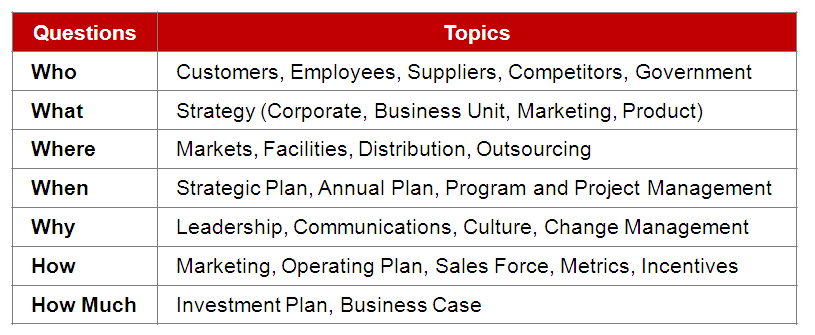Who, What, Why, When, Where?
These are five questions kids learn in grade school or when first learning a language. It covers the basics and helps you understand the situation and context. My high school friends can attest to my poor memory, but even I can remember these basic words in french: Qui, Quoi, Quand, Où, Pourquoi. These 5 questions are fairly famous and an often-quoted way to think through problems. They have been repeated by Cicero, Thomas Acquinas, and Rudyard Kipling. Journalists are trained to answer those 5 questions whenever they write an article or press release. It’s a good checklist, yes?
These can also be useful for consultants, with two small additions. How and How Much?
For any consultant eager to see her recommendations implemented, a lot of thought needs to be given to how it will be implemented and how much it might cost. For all the snark-y comments about strategy consultants giving high-minded solutions that are condemned to be “shelfware”, there is a hint of truth that many good ideas die on the hill of implementation and cost.
What kind of problem is it?
There is a good chance that the client’s problem falls into one of these buckets. If it is a strategy project, likely it is a WHAT question. Conversely, if it is a operations-related project, it is really looking at HOW to implement a good idea efficiently. Most seasoned consultants have been on projects that touch these areas.

Answer the right question
It is easy to fall into the trap of addressing the wrong issue. All too often clients hire consultants to solve problem X, only to find out that the problem is actually with Y. On a more personal note, I had dinner with a good friend last night and he adroitly pointed out that I was too focused on answering the HOW on a big decision in my life, instead of taking a step back and answering the WHY and the WHAT. Sanity check.
“Management is doing things right; leadership is doing the right things.” – Peter Drucker
Think broadly about the problem
Once you have targeted the right question, think a bit more laterally and see which of the other questions should be answered too. The level of detail will vary, but you want to be as comprehensive as the time and budget allows. In this example below, this hypothetical project actually covers a lot of ground.
Look for the add-on work
Chances are very good that during the course of solving one problem, you unearth other issues. It is all too common for a $50,000 (loss-leader) diagnostic project to lead to a $750,000 (profitable) project with multiple work streams and larger consultant teams. Clients see that you do good work, and want more help. It is natural and good thing for the client and the consultant. Look for those opportunities.
“My greatest strength as a consultant is to be ignorant and ask a few questions.” – Peter Drucker
Related Posts:
5 Consulting Courses
Available on Coursera
Yes, I’ve spent months in the studio, recording 5 courses for Coursera.
I’d like to share my experiences and advice on how we can all work like consultants; smarter and faster.
You can audit the classes for free, or pay to get the full experience and certification.
Click any of the buttons.
